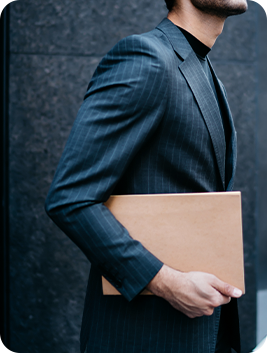 Ladies, coming for a job interview dressed as you were heading for the night-club on Saturday night, will simply not do it.
Ladies, coming for a job interview dressed as you were heading for the night-club on Saturday night, will simply not do it.
🚀 You are wasting your time turning up in a very short skirt and plunging neckline.
💥 Forget the high heel gold stiletto platforms with a 23 cm spike heel, extreme facial piercing, big hoop earrings and excessive jewellery with heavy makeup.
Gentlemen, you may be proud of your nose, ear or lips piercing, cool tattoos, light makeup and eye mascara.
- If you feel the fashion includes extremely long fingernails, believe me, you are not making it easier for yourself if your dream is to work for a multinational company.
- BULLET And don’t turn up in jeans and jogging shoes, please.
You never get a second chance to make a first impression
If you are old enough, you may recall the shampoo commercial, “You never get a second chance to make a first impression”.
You must have heard the saying that a first impression can make or break a business opportunity or relationship.
That includes anything from meeting customers, pitching your business to new clients, to dating for a romantic partner, and of course very much to job interviewing.
How true that old commercial is by the way.
It takes less than a second for your brain to decide if you like – or not – that other person you are meeting.
It’s your appearance that is usually the first reference for people.
Needless to say, in a job interview situation you must be aware of how important it is to quickly make a brilliant first impression.
The dress code for a job interview may also be what you are expected to follow once you get the job; but there are many companies where you are allowed to be more relaxed and casual.
What exactly is our first judgment based on?
 I have first-hand experience with “first impressions” and how some candidates start on the wrong foot by not respecting the dress code.
I have first-hand experience with “first impressions” and how some candidates start on the wrong foot by not respecting the dress code.
The first judgement the interviewer makes is based on how you look, your appearance from hair to shoes, what you are wearing, body language, your smile, and even your handshake and greetings.
Dressing appropriately for the job interview is an important aspect of introducing yourself; as essential as presenting your work experience and answering the interview questions.
Certain jobs have developed their own dress code culture. Take creative professions such as advertising where you see a more casual and relaxed dress code.
Staff in the creative departments have no rules and can turn up in Lady Gaga outfits (read: silly and outrageous), but there are still other expectations for a more conservative style when working in marketing or accounting.
So as an accountant interviewing for a job in advertising, but dressed like a creative, will not do you any favours.
Single most important dress code advice
Probably the single most important advice I can give; dress in a way that says you mean business, dress smartly for the interview and rather be overdressed than seen as disrespectful, cheap and untidy.
You must dress the same way whether meeting a recruiter in a recruitment or executive search firm or the hiring manager representing the employer.
Remember that a third party- and even a corporate recruiter (HR, Talent Acquisition) is a filter and will make his or her own judgment if your style matches the client’s culture.
How should women dress for a job in the city?
 If you are interviewing for a job in the city, not at a factory, dress conservatively like a pencil skirt and a jacket, shoes that completely cover the toes, light make-up, discreet earrings and jewelry accessories. No nail polish or use polish that matches your skin colour.
If you are interviewing for a job in the city, not at a factory, dress conservatively like a pencil skirt and a jacket, shoes that completely cover the toes, light make-up, discreet earrings and jewelry accessories. No nail polish or use polish that matches your skin colour.
The pencil skirt you male readers may ask?
- A pencil skirt is a slim-fitting skirt with a straight, narrow cut. Generally, the hem falls to the knees, or just below, and is tailored for a close fit. It is named for its shape: long and slim like a pencil.
Do shoes really make a woman? Absolutely. And absolutely.
An industry that has figured this out the best, is the hospitality industry.
Go to any hotel lobby and observe.
The female staff are all wearing closed-toe shoes (any shoe that completely covers the toes), black, brown or neutral colour.
If you are comfortable wearing heels, then, by all means, go for it.
If not, then opt for a good pair of flats. Stay classy with whatever choice, because a great pair of shoes is the finishing touch that seals the deal.
Dress code if working in a factory
But what if you are working in a factory and wear a uniform every day?
If you are taking time off during a working day to attend a job interview, but must return to work right after the interview, do two things:
- Tell the recruiter or HR manager that you will be coming from work wearing the company uniform, and must return to work.
- Ask them to inform the hiring manager, if that is whom you interview with.
- When you arrive for the interview, you should apologise that you wear a uniform because you come from work and will return to work after the meeting.
If you don’t wear a uniform, or perhaps have taken a day off to attend a job interview, then men should wear a tie but with no jacket.
Yes, a tie even that will be the first and last time because of local safety precautions.
But a tie does improve first impression and is a sign of respect to the manager you are meeting. A white or single-coloured shirt will do well.
In a factory environment, slacks (pants, trousers) for women combined with just a shirt will be acceptable.
How should men dress?
 You should wear professional or business, attire.
You should wear professional or business, attire.
Even if the company that you are interviewing with is known for its casual dress code and no-one wears a tie or a jacket, your first meeting with the HR or hiring manager is getting the wow, great first impression, building an instant rapport.
The minimum is a neutral-coloured shirt with a matching tie, dark trousers and really good shoes.
A jacket or not depends on the type of business; if businesses like banking, finance, and consulting where a jacket or a suit is the norm, you must dress that way.
I still don’t get why an unshaven look has become such a fashion, even some men carry it quite well. Think singer George Michael.
But most of us look like something the cat has dragged in from the streets. It’s a fine balance between looking modern, cool, masculine, attractive on one hand; or tired, exhausted, worn out, untidy and dirty on the other.
So, gentlemen, the word is clean-shaven to nail that first impression; unless you have a proper thick full full-grown beard or moustache that’s trimmed to perfection.
I would always advise that you buy an expensive pair of business shoes even before buying your second jacket or one more suit.
My mother always taught me that you can “tell a man by his shoes”. And that is still the way it is today.
But again, dress in a way that says you mean business, dress smartly for the interview and rather be overdressed than seen as disrespectful, cheap and untidy.
Style isn’t expensive, fashion is!
When you feel good about what you are wearing, you will feel confident and positive. Do not go overboard in acquiring fashion and designer brands.
You need to dress appropriately and through the right choice you show respect to the interviewer.
You also need to know the definitions of formal, business attire, informal, and the often-used “smart casual”.
The Macquarie Dictionary defines “smart casual” as well-dressed in a casual style.
The Oxford Dictionary defines “smart casual” as neat, conventional, yet relatively informal in style,

